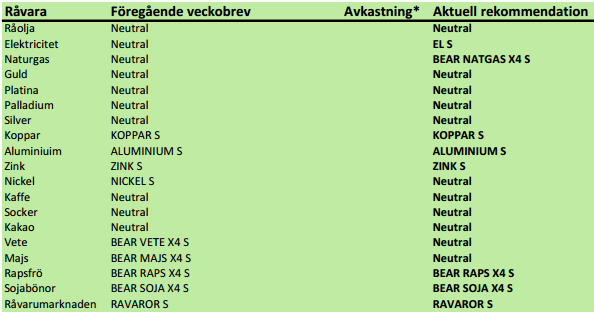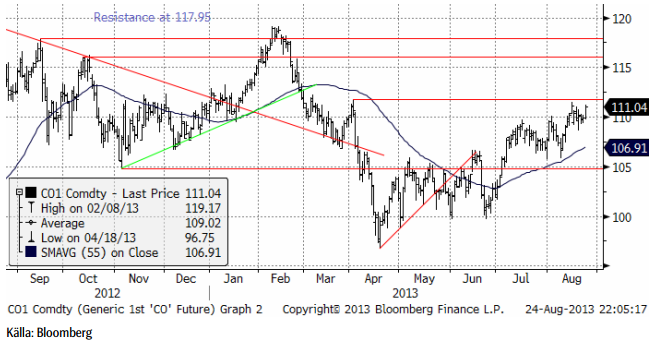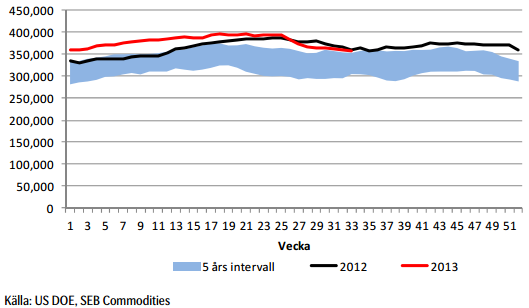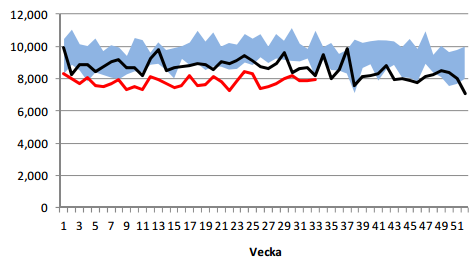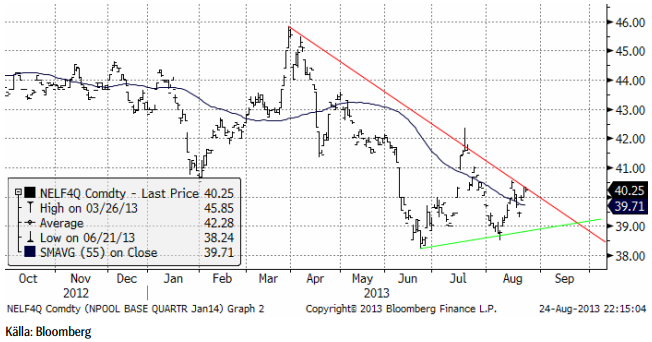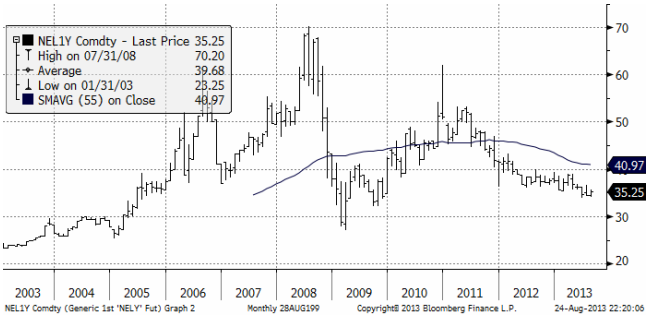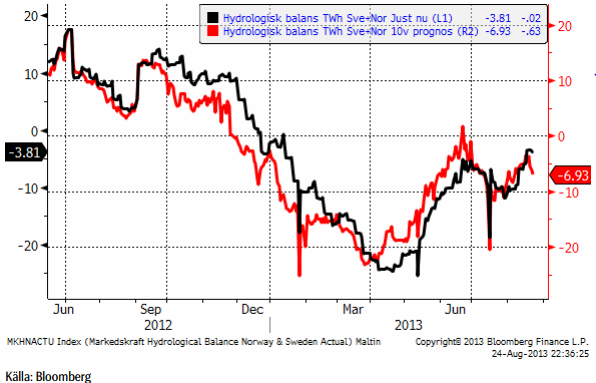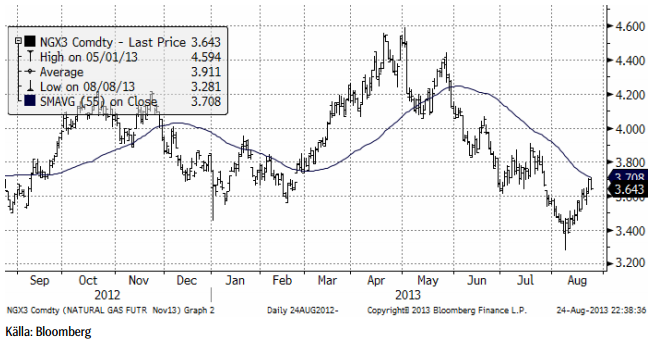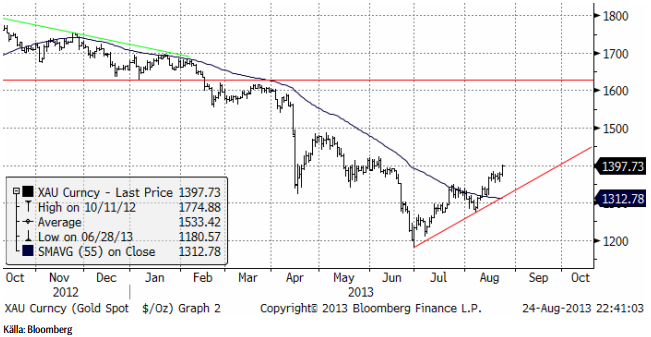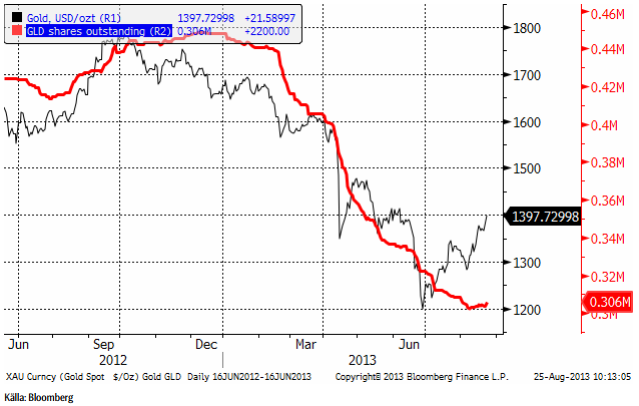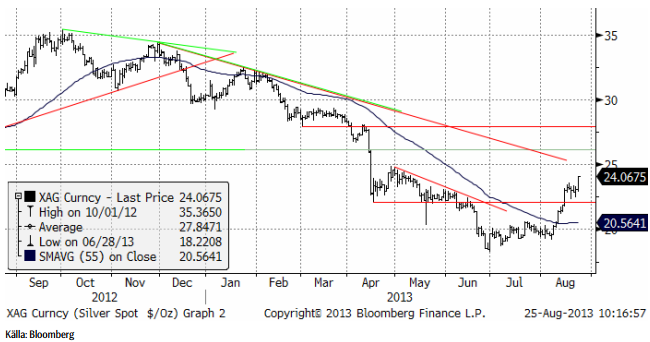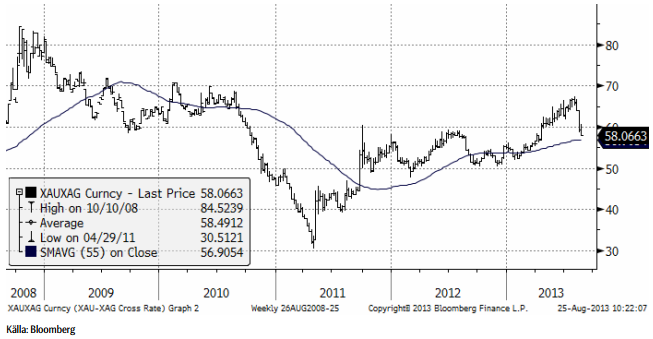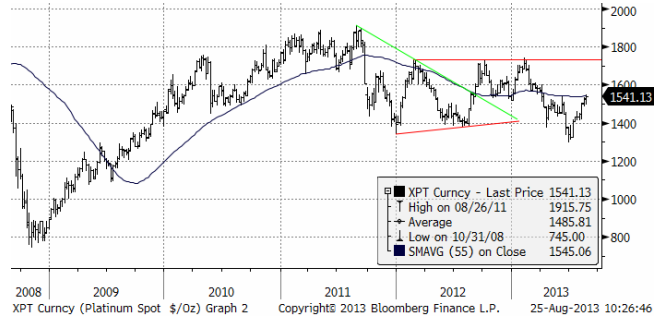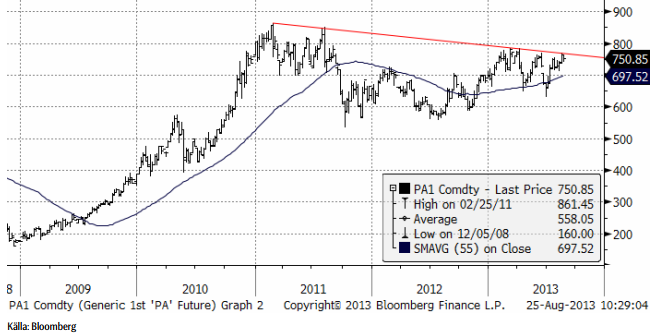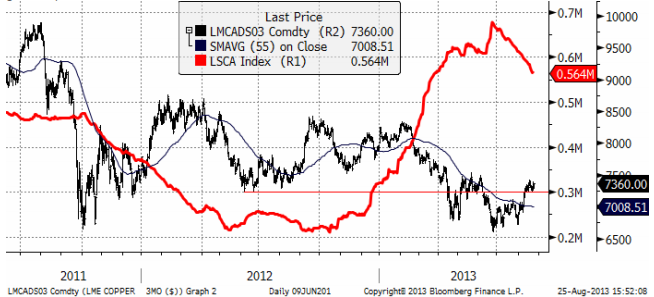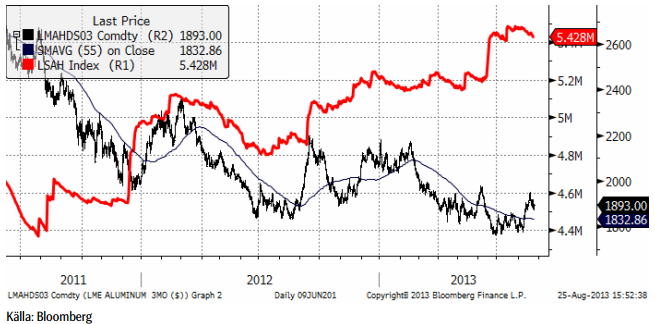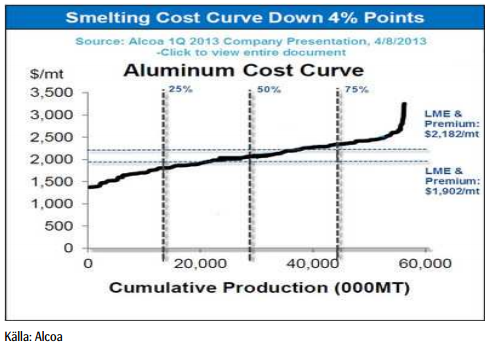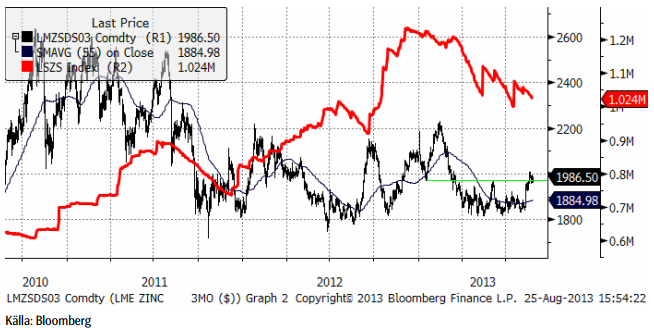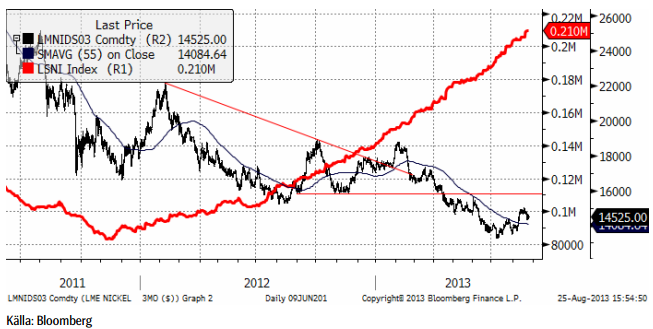Analys
SEB – Råvarukommentarer, 26 augusti 2013

Rekommendationer
*) Avkastningen lämnar vi blank här eftersom det har varit ett två månaders uppehåll. Generellt sett har dock rekommendationerna varit lyckosamma med kraftiga nedgångar i priset på t ex spannmål och oljeväxter och prisuppgång på basmetaller.
Inledning
I detta första veckobrev efter sommaruppehållet går vi över till neutral på vete och majs, men behåller sälj på soja och raps, som idag rusat nästan 100 cent (sojan) och rapsen förmodligen öppnar upp kraftigt idag vid 11-tiden när börsen öppnar. Det handlar dock om rekyler. I synnerhet raps tycker vi ser färdigt ut vad gäller rekylen och rekommenderar en kortsiktig kort position, dvs BEAR RAPS X4 S.
Vi går också över till neutral på silver och guld. Det hade varit köp för några veckor sedan, men rekylen har gått för långt upp nu.
Vi går över till köp-rekommendation på elen. Det är historiskt låga priser och även om ”tajmingen” kan vara lite ”off” i värsta fall, tror vi att priset generellt sett kommer att vara högre i framtiden. Oljepriset har stärkt sig, som vi trott, men ligger nu väl högt. Oljemarknaden är speciell som placering, eftersom ”backwardation” genererar inkomster till certifikatinnehavaren över tid. Men det är en fördel om man kan göra placeringen på en lägre prisnivå än dagens.
Många råvaror ligger sedan lång tid i fallande pristrender. Några har gjort det i nästan tre år som kaffe och socker, några har gjort det sedan i december (spannmål och oljeväxter) och några tycks ha nått det ”fundamentala golvet” redan, som utgörs av att produktionskostnaden är högre än dagspriset. Då de tar tid för producenter att fatta att det finns en överproduktion, som måste rättas till genom att lägga ner, finns en möjlighet för priset att göra en ”overshooting”. Vi tror att det är vad som håller på att hända i råvarumarknaden. I vissa fall, som ädelmetallerna guld och silver, har återhämtningen redan kommit igång. I andra har det ännu inte inträffat, som t ex i kaffe och socker. Vad gäller vete och oljeväxter kanske den här fasen inte nås förrän nästa år.
Samtidigt har det nyligen publicerats överraskande postiva data på hur eknomin går i världen. I förra veckan publicerades överraskande positiv inköpschefsstatistik i Kina, Tyskland och Europa som helhet. Huspriserna i USA steg med 7.7% jämfört med förra året i juni. De ledande indikatorerna för USA:s ekonomi fortsätter att stärkas. Nu är de på sin högsta nivå sedan sommaren 2008. Detta bör allt annat lika leda till högre efterfrågan på råvaror. Häri finns kanske ”triggern” som kan få priser på vissa råvaror att stiga, givet att ett tidigare överskott i produktionskapacitet reducerats.
Detta gör också råvaror till ett intressant placeringsalternativ när räntorna stiger och gör obligationer oattraktiva, börsen fått säljrekommendation av flera stora globala investmentbanker (Morgan Stanley förutspår t ex en 10% korrigering under hösten).
Råolja – Brent
I det sista veckobrevet innan sommaruppehållet skrev jag att ”Tekniskt ser det ut som om uppgången har goda chanser att bryta igenom motståndet på 105 dollar och kanske gå upp mot 107 dollar i det mycket korta perspektivet av den kommande veckan. ”Vad vi fick var en uppgång till strax under 107 dollar, sedan en kraftig rekyl ner till 100 dollar och därefter en ny uppgång som fortfarande pågår. I fredags stängde spotkontraktet på 111.04 dollar. Som vi ser i diagrammet nedan, finns ett motstånd på 111.87 dollar, markerad av toppen i början på april och testad (höll) nu i augusti.
Råoljelagren i USA, som vi vant oss vid att se på en hög nivå, har fallit och ligger nu under förra årets nivå och nära det femåriga intervallet för åren 2007 – 2011. Nedan ser vi amerikanska råoljelager enligt DOE i tusen fat. Den svarta kurvan är 2012 års lagernivåer vecka för vecka och den lilla röda linjen är 2013 års nivå.
Importen fortsätter att hålla sig under förra årets nivå.
Vår vy är neutral. Det kan bli svårt för oljepriset att ta sig över det tekniska motståndet på 111.87 dollar.
Elektricitet
Tidningen Privata Affärer publicerade i veckan som gick en artikel om de låga vattennivåerna i magasinen – med varningen att elpriset kan bli högt i vinter. Eftersom fokus redan är på elpriset i vinter, hoppar vi direkt till första kvartalets kontrakt. Det är inte det som är underliggande för EL S och BULL EL X4 S just nu, men i början på september rullas det in i det kontraktet, så vi kan lika gärna titta på det nu. Rullning betyder att värdeförändringen på certifikaten slutar att uppdateras med de procentuella dagsförändringarna i priset på det tredje kvartalets kontrakt och ersätts med de procentuella dagsförändringarna i det fjärde kvartalets kontrakt. Även om kontrakten prismässigt ligger på olika nivåer, blir det alltså inget ”hopp” i värdet på certifikatet.
Nedan ser vi prisdiagrammet på det första kvartalets 2014 kontrakt. Vad vi ser är successivt lägre toppar sedan mars månad, och successivt högre bottnar sedan juni. Detta bildar en inom den tekniska analysen, klassiskt så kallad ”triangelformation”. Man ser dem ofta vid trendvändningar. I det här fallet är den huvudsakliga trenden nedåtriktad. Man bör alltid vänta på utbrott från triangeln, men med tanke på dels att priset är riktigt lågt i ett historiskt perspektiv och att det varit en varm och regnfattig sommar, med underskott i vattenmagasinen, ett år äldre kärnkraftverk, så skulle det inte förvåna om priset steg.
Vi ska se lite mer i perspektiv hur lågt elpriset är just nu. Nedan ser i spotkontraktet på ”årskontraktet” för el, dvs vad det skulle kosta att prissäkra ett helt kalenderår. Just nu är underliggande priset för att prissäkra leverans av el under hela år 2014. Diagrammet är på månadsbasis.
Vi tror att det är riktigt låga priser på el just nu. Det är orsakat av riktigt låga priser på kol, bottennivåer på utlsläppsrätter och allmän lågkonjunktur. Även om ”tajmingen” kan missa, är elpriset nedtryckt av att alla faktorer är i botten. Det borde rimligtvis vara bättre att vara köpt än att vara såld elpriset. I synnerhet som tillväxten, t ex i USA tycks vara på väg tillbaka.
Hydrologisk balans har fortsatt att stiga, som vi ser i nedanstående diagram.
Däremot ser vi också att prognosen för 10 veckor framåt pekar nedåt. Den har varit en god indikator tidigare och uppvisar också trender.
Vi rekommenderar alltså försiktigt köp av el, t ex EL S, som har mindre risk än BULL EL X4 S.
Naturgas
Naturgaspriset har varit fallande sedan maj, men har rekylerat upp i augusti. Vi tror att det handlar om just en rekyl och att priset kommer att vända ner igen.
EIA räknar med att år 2013 blir det sjätte året på raken med rekordproduktion av naturgas i USA.
Guld & Silver
Guldpriset har rekylerat upp och nått upp till nivåer där rekylen torde stöta på motstånd i det korta perspektivet.
Den största börshandlade investeringsprodukten på guld, GLD, som investerare sålt av friskt under våren, har faktiskt attraherat nettoinflöden för första gången sedan november förra året. Vi ser antal GLD-bevis utestående i röd kurva nedan och guldpriset som den tunnare svarta.
Återigen ser vi att det faktiskt är guldpriset som är den ledande faktorn och investerarna som följer efter.
Nedan ser vi kursdiagrammet för silver i dollar per troy ounce. I fredags bröt priset upp från en flagga. Flagg-formationer ser man ofta i efterhand ”på halv stång”, dvs i mitten av en uppgång. Detta gör att prisuppgången skulle kunna nå upp till 27 dollar per ozt. Å andra sidan finns ett starkt motstånd redan vid 25 dollar, där rekylen uppåt i april tog slut.
Innan sommaruppehållet skrev jag att nedgången troligtvis skulle nå så långt ner som till 20 dollar. Vi vill knappast fortsätta vara köpta i BEAR och har förhoppningsvis lämnat den positionen under sommaren, men i dagsläget vill vi inte heller riktigt gå in i BULL, eftersom det är så nära motstånd strax ovanför dagens nivå. Vi avvaktar ett bättre köptillfälle, alltså.
Nedan ser vi kvoten mellan guldpriset och silverpriset. När folk under 2011 trodde att en storbank sålt mer ”papperssilver” än vad som fanns i världen, gick kvoten ner till rekordlåga 30. Därefter har silver tappat mark dubbel så mycket som guld och kvoten nästan nått 70. Detta hänger ihop med baisse-marknaden. Silver brukar ta ut svängarna mer än vad guldmarknaden gör. När så vinden vände i augusti, har silvermarknaden varit snabbare än guldmarknaden. Silver handlar nu i linje med det historiska medelvärdet på kvoten till guld, som är ca 50. Idag är det alltså egalt om man köper silver eller guld.
Platina & Palladium
Amplats, som under sex månader gått igenom sin verksamhet har kommit fram till att reducera arbetsstyrkan med 6900 personer, vilket är mindre än de 14,000 som bolaget initialt siktat på i januari. 6,900 anställda är 12.5% av de totalt 48,000 anställda. Som tidigare har meddelats minskar produktionen till 2.2 – 2.4 miljoner troy uns (mozt). Produktionen förra året (2012) var 2.38 moztoch under 2011, 2.53 mozt. 2012 års produktion drabbades av strejkerna vid gruvorna i Sydafrika. Produktionsneddragningarna går långsammare än väntat och den här besvikelsen är tydligt ”bearish”.
Platina har stigit upp till ett tekniskt motstånd, där priset har vänt ner tidigare i år. Nedan ser vi ett veckochart för de senaste fem åren. Det är ett otydligt läge, där motståndet som finns vid dagens nivå spelar en avgörande roll.
Palladiumpriset ligger precis under ett tekniskt motstånd. Det är en mycket spännande situation rent tekniskt. Motståndet har hållit så många gånger, att ett brott uppåt från den skulle signalera en större förändring i palladiummarknaden. Än så länge ser motståndet dock ut att hålla. Gissningsvis håller motståndet och priset rekylerar nedåt i det korta perspektivet. Skulle motståndet brytas uppåt, vill vi naturligtvis vara köpta palladium.
Vi är för närvarande neutrala platina och palladium.
Koppar
Kinas har länge hämtat material från sina lager som i mars var 1 miljon ton koppar. Nu har lagren nått ner till 300 tton. Kinas import har därför tvingats vända upp under sommaren. ICSG publicerade estimat i maj, som visade en efterfrågan större än utbudet (underskott) för första gången på 7 månader. Underskottet var 17,000, ton, men ändå ett underskott. De första fem månaderna i år visade på ett överskott på 250,000 ton. Under förra året var marknaden i underskott med 400,000 ton. Det tycks onekligen som om kopparmarknaden har blivit bättre balanserad än vad man tidigare trott. Vi tror därför att priset har gott stöd på nedsidan.
Vi förväntar oss fortsatt hög volatilitet. Vår kortsiktiga bedömning talar för uppsidan och vi rekommenderar därför köp av BULL KOPPAR X2 S eller X4 S.
Aluminium
Det har under lång tid producerats mer aluminium än vad som efterfrågats och priset har legat under den nivå som krävs för lönsamhet. Under det första halvåret i år gjordes dock produktionsneddragningar i Kina på 600 – 700 tusen ton. Denna produktionsneddragning har dock ersatts av ny kapacitet. Rusal presenterade mer omfattande försök att åtminstone få marknaden i balans. När bolaget presenterade sin halvårsrapport, annonserade de produktionsneddragningar på 300 till 357 tusen ton. De uppmanade också branschkollegor att göra detsamma. De sade att 2/3 av global produktion var olönsam vid dagens priser. Alcoa var näst på tur att rapportera och de annonserade en neddragning på 200 tusen ton i Brasilien. Det finns mycket kvar att göra i en marknad som årligen har ett överskott på 500,000 – 1 miljon ton. Efterfrågan ökar med ungefär 6% per år. Premier för fysisk vara har sjunkit som en effekt av LME:s förslag som syftar till att korta köerna i LME-systemet. Vi förväntar oss en gradvis effekt på produktionen det kommande året – dvs successivt lägre fysiska premier och ytterligare produktionsneddragningar.
Nedan ser vi produktionskostnadskurvan och LME priset + den fysiska premien.
Zink
Sedan kursfallet under våren har priset på zink funnit stöd vid 1800 dollar per ton och konsoliderat mellan den nivån på nedsidan och 1950 dollar på ovansidan. I slutet av juli / början av augusti tog sig priset över motståndet.
Fundamentalt har zink i flera år varit överskott, dvs produktionen har varit större än konsumtionen. Enligt ILZG visade det första halvåret i år ett överskott på 44,000 ton. Det ska jämföras med överkottet på 157 ton förra året. ”Bull caset” på zink, som baserar sig på att en betydande gruvkapacitet kommer att stängas de närmaste åren, är fortfarande intakt. Gruvor med 1.5 mt produktion per år väntas stänga under perioden 2013 – 2016. 450,000 ton gruvproduktion förväntas bli nedlagd under 2013 –
2014.
Nedan ser vi kursgrafen och lagren vid LME.
Som vi ser är lagren mycket stora – över 1 miljon ton – bara i LME:s lagerhus.
Nickel
Det huvudsakliga diskussionsämnet i nickelmarknaden är alltjämt överproduktionen av tackjärn med nickelinnehåll i Kina (så kallat Nickel Pig Iron, NPI). Den senaste tekniken, RKEF, har sänkt marginalkostnaden, vilket ytterligare pressat priserna. Detta visar hur viktig teknikutveckling kan vara för prisutvecklingen på råvaror, vilket bland andra ekonomiprofessorn Julian Simon förklarat. En effekt av den ökade användningen av NPI hos kinesiska producenter av rostfritt stål, är ett överutbud av nickel i Kina. Rekordnivån på LME-lagren har huvudsakligen orsakats av inleveranser till lagerhuset i Johor i Malaysia. Det handlar troligen om metall som exporterats från Kina.
Gruvbranschen lider definitivt av dagens låga priser och marknaden behöver se gruvor läggas ner för att åstadkomma balans i utbud och efterfrågan.
[box]SEB Veckobrev Veckans råvarukommentar är producerat av SEB Merchant Banking och publiceras i samarbete och med tillstånd på Råvarumarknaden.se[/box]
Disclaimer
The information in this document has been compiled by SEB Merchant Banking, a division within Skandinaviska Enskilda Banken AB (publ) (“SEB”).
Opinions contained in this report represent the bank’s present opinion only and are subject to change without notice. All information contained in this report has been compiled in good faith from sources believed to be reliable. However, no representation or warranty, expressed or implied, is made with respect to the completeness or accuracy of its contents and the information is not to be relied upon as authoritative. Anyone considering taking actions based upon the content of this document is urged to base his or her investment decisions upon such investigations as he or she deems necessary. This document is being provided as information only, and no specific actions are being solicited as a result of it; to the extent permitted by law, no liability whatsoever is accepted for any direct or consequential loss arising from use of this document or its contents.
About SEB
SEB is a public company incorporated in Stockholm, Sweden, with limited liability. It is a participant at major Nordic and other European Regulated Markets and Multilateral Trading Facilities (as well as some non-European equivalent markets) for trading in financial instruments, such as markets operated by NASDAQ OMX, NYSE Euronext, London Stock Exchange, Deutsche Börse, Swiss Exchanges, Turquoise and Chi-X. SEB is authorized and regulated by Finansinspektionen in Sweden; it is authorized and subject to limited regulation by the Financial Services Authority for the conduct of designated investment business in the UK, and is subject to the provisions of relevant regulators in all other jurisdictions where SEB conducts operations. SEB Merchant Banking. All rights reserved.
Analys
Tightening fundamentals – bullish inventories from DOE

The latest weekly report from the US DOE showed a substantial drawdown across key petroleum categories, adding more upside potential to the fundamental picture.

Commercial crude inventories (excl. SPR) fell by 5.8 million barrels, bringing total inventories down to 415.1 million barrels. Now sitting 11% below the five-year seasonal norm and placed in the lowest 2015-2022 range (see picture below).
Product inventories also tightened further last week. Gasoline inventories declined by 2.1 million barrels, with reductions seen in both finished gasoline and blending components. Current gasoline levels are about 3% below the five-year average for this time of year.
Among products, the most notable move came in diesel, where inventories dropped by almost 4.1 million barrels, deepening the deficit to around 20% below seasonal norms – continuing to underscore the persistent supply tightness in diesel markets.
The only area of inventory growth was in propane/propylene, which posted a significant 5.1-million-barrel build and now stands 9% above the five-year average.
Total commercial petroleum inventories (crude plus refined products) declined by 4.2 million barrels on the week, reinforcing the overall tightening of US crude and products.


Analys
Bombs to ”ceasefire” in hours – Brent below $70

A classic case of “buy the rumor, sell the news” played out in oil markets, as Brent crude has dropped sharply – down nearly USD 10 per barrel since yesterday evening – following Iran’s retaliatory strike on a U.S. air base in Qatar. The immediate reaction was: “That was it?” The strike followed a carefully calibrated, non-escalatory playbook, avoiding direct threats to energy infrastructure or disruption of shipping through the Strait of Hormuz – thus calming worst-case fears.

After Monday morning’s sharp spike to USD 81.4 per barrel, triggered by the U.S. bombing of Iranian nuclear facilities, oil prices drifted sideways in anticipation of a potential Iranian response. That response came with advance warning and caused limited physical damage. Early this morning, both the U.S. President and Iranian state media announced a ceasefire, effectively placing a lid on the immediate conflict risk – at least for now.
As a result, Brent crude has now fallen by a total of USD 12 from Monday’s peak, currently trading around USD 69 per barrel.
Looking beyond geopolitics, the market will now shift its focus to the upcoming OPEC+ meeting in early July. Saudi Arabia’s decision to increase output earlier this year – despite falling prices – has drawn renewed attention considering recent developments. Some suggest this was a response to U.S. pressure to offset potential Iranian supply losses.
However, consensus is that the move was driven more by internal OPEC+ dynamics. After years of curbing production to support prices, Riyadh had grown frustrated with quota-busting by several members (notably Kazakhstan). With Saudi Arabia cutting up to 2 million barrels per day – roughly 2% of global supply – returns were diminishing, and the risk of losing market share was rising. The production increase is widely seen as an effort to reassert leadership and restore discipline within the group.
That said, the FT recently stated that, the Saudis remain wary of past missteps. In 2018, Riyadh ramped up output at Trump’s request ahead of Iran sanctions, only to see prices collapse when the U.S. granted broad waivers – triggering oversupply. Officials have reportedly made it clear they don’t intend to repeat that mistake.
The recent visit by President Trump to Saudi Arabia, which included agreements on AI, defense, and nuclear cooperation, suggests a broader strategic alignment. This has fueled speculation about a quiet “pump-for-politics” deal behind recent production moves.
Looking ahead, oil prices have now retraced the entire rally sparked by the June 13 Israel–Iran escalation. This retreat provides more political and policy space for both the U.S. and Saudi Arabia. Specifically, it makes it easier for Riyadh to scale back its three recent production hikes of 411,000 barrels each, potentially returning to more moderate increases of 137,000 barrels for August and September.
In short: with no major loss of Iranian supply to the market, OPEC+ – led by Saudi Arabia – no longer needs to compensate for a disruption that hasn’t materialized, especially not to please the U.S. at the cost of its own market strategy. As the Saudis themselves have signaled, they are unlikely to repeat previous mistakes.
Conclusion: With Brent now in the high USD 60s, buying oil looks fundamentally justified. The geopolitical premium has deflated, but tensions between Israel and Iran remain unresolved – and the risk of missteps and renewed escalation still lingers. In fact, even this morning, reports have emerged of renewed missile fire despite the declared “truce.” The path forward may be calmer – but it is far from stable.
Analys
A muted price reaction. Market looks relaxed, but it is still on edge waiting for what Iran will do

Brent crossed the 80-line this morning but quickly fell back assigning limited probability for Iran choosing to close the Strait of Hormuz. Brent traded in a range of USD 70.56 – 79.04/b last week as the market fluctuated between ”Iran wants a deal” and ”US is about to attack Iran”. At the end of the week though, Donald Trump managed to convince markets (and probably also Iran) that he would make a decision within two weeks. I.e. no imminent attack. Previously when when he has talked about ”making a decision within two weeks” he has often ended up doing nothing in the end. The oil market relaxed as a result and the week ended at USD 77.01/b which is just USD 6/b above the year to date average of USD 71/b.

Brent jumped to USD 81.4/b this morning, the highest since mid-January, but then quickly fell back to a current price of USD 78.2/b which is only up 1.5% versus the close on Friday. As such the market is pricing a fairly low probability that Iran will actually close the Strait of Hormuz. Probably because it will hurt Iranian oil exports as well as the global oil market.
It was however all smoke and mirrors. Deception. The US attacked Iran on Saturday. The attack involved 125 warplanes, submarines and surface warships and 14 bunker buster bombs were dropped on Iranian nuclear sites including Fordow, Natanz and Isfahan. In response the Iranian Parliament voted in support of closing the Strait of Hormuz where some 17 mb of crude and products is transported to the global market every day plus significant volumes of LNG. This is however merely an advise to the Supreme leader Ayatollah Ali Khamenei and the Supreme National Security Council which sits with the final and actual decision.
No supply of oil is lost yet. It is about the risk of Iran closing the Strait of Hormuz or not. So far not a single drop of oil supply has been lost to the global market. The price at the moment is all about the assessed risk of loss of supply. Will Iran choose to choke of the Strait of Hormuz or not? That is the big question. It would be painful for US consumers, for Donald Trump’s voter base, for the global economy but also for Iran and its population which relies on oil exports and income from selling oil out of that Strait as well. As such it is not a no-brainer choice for Iran to close the Strait for oil exports. And looking at the il price this morning it is clear that the oil market doesn’t assign a very high probability of it happening. It is however probably well within the capability of Iran to close the Strait off with rockets, mines, air-drones and possibly sea-drones. Just look at how Ukraine has been able to control and damage the Russian Black Sea fleet.
What to do about the highly enriched uranium which has gone missing? While the US and Israel can celebrate their destruction of Iranian nuclear facilities they are also scratching their heads over what to do with the lost Iranian nuclear material. Iran had 408 kg of highly enriched uranium (IAEA). Almost weapons grade. Enough for some 10 nuclear warheads. It seems to have been transported out of Fordow before the attack this weekend.
The market is still on edge. USD 80-something/b seems sensible while we wait. The oil market reaction to this weekend’s events is very muted so far. The market is still on edge awaiting what Iran will do. Because Iran will do something. But what and when? An oil price of 80-something seems like a sensible level until something do happen.
-

 Nyheter3 veckor sedan
Nyheter3 veckor sedanMahvie Minerals växlar spår – satsar fullt ut på guld
-

 Nyheter4 veckor sedan
Nyheter4 veckor sedanUppgången i oljepriset planade ut under helgen
-

 Nyheter4 veckor sedan
Nyheter4 veckor sedanLåga elpriser i sommar – men mellersta Sverige får en ökning
-

 Nyheter3 veckor sedan
Nyheter3 veckor sedanJonas Lindvall är tillbaka med ett nytt oljebolag, Perthro, som ska börsnoteras
-

 Analys3 veckor sedan
Analys3 veckor sedanA muted price reaction. Market looks relaxed, but it is still on edge waiting for what Iran will do
-

 Nyheter3 veckor sedan
Nyheter3 veckor sedanOljan, guldet och marknadens oroande tystnad
-

 Analys4 veckor sedan
Analys4 veckor sedanVery relaxed at USD 75/b. Risk barometer will likely fluctuate to higher levels with Brent into the 80ies or higher coming 2-3 weeks
-

 Nyheter3 veckor sedan
Nyheter3 veckor sedanDomstolen ger klartecken till Lappland Guldprospektering


